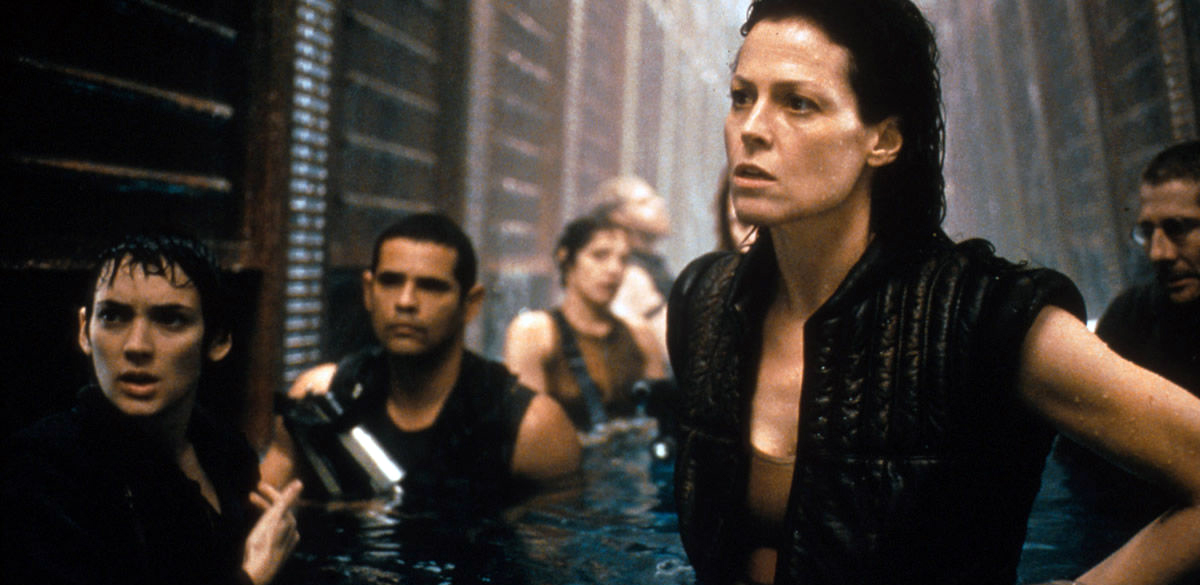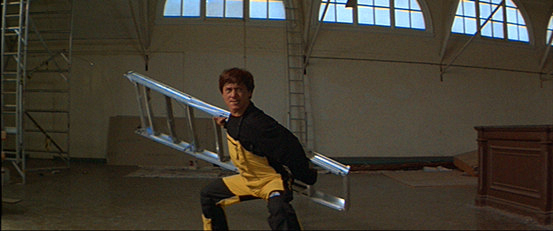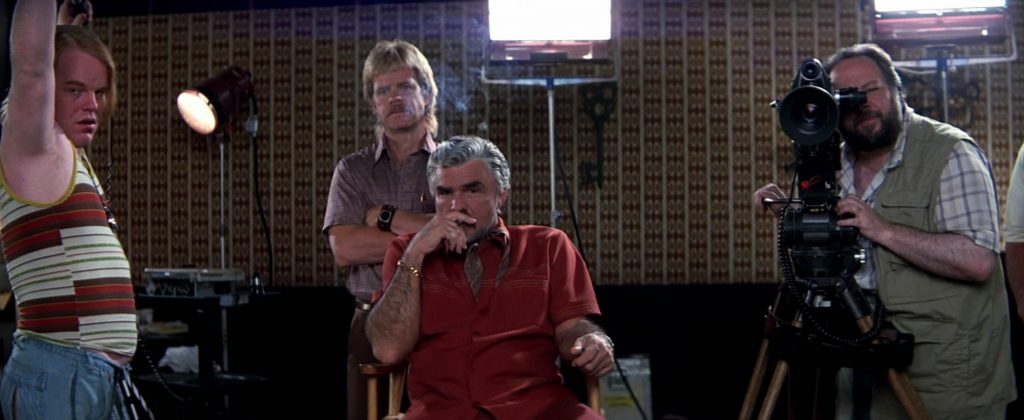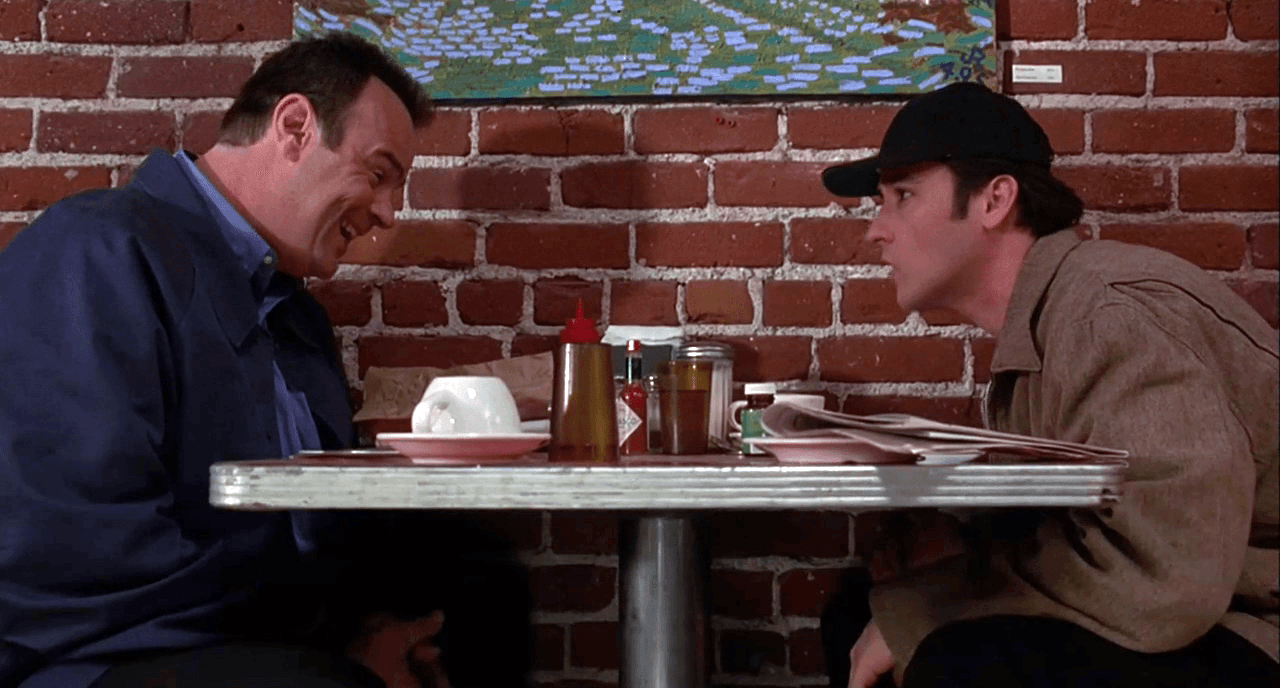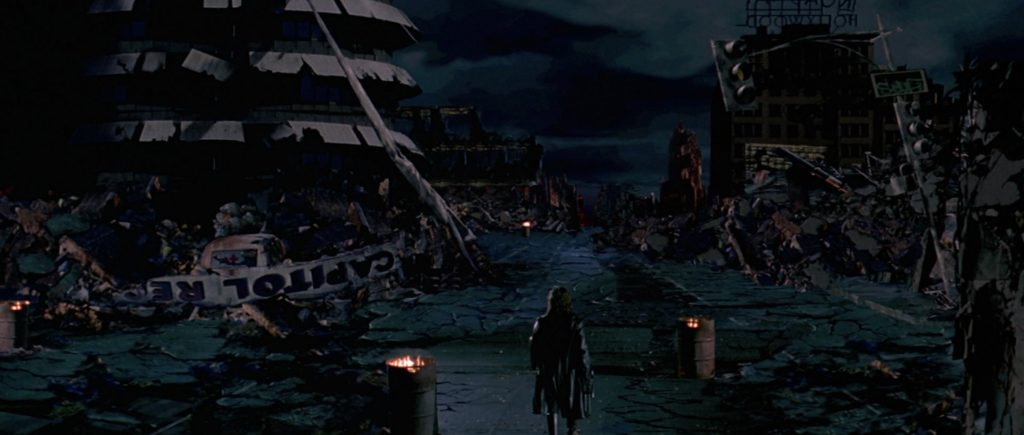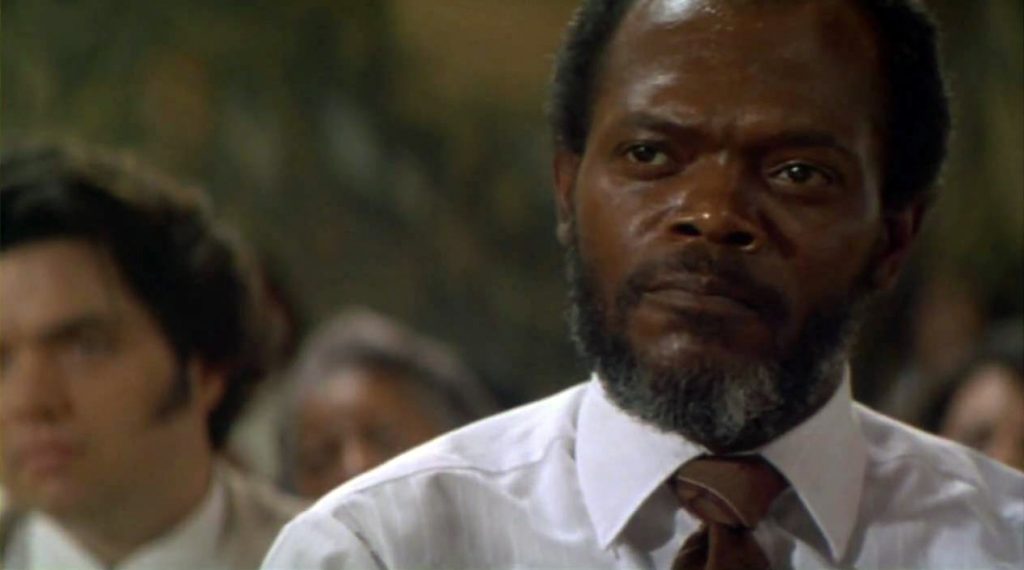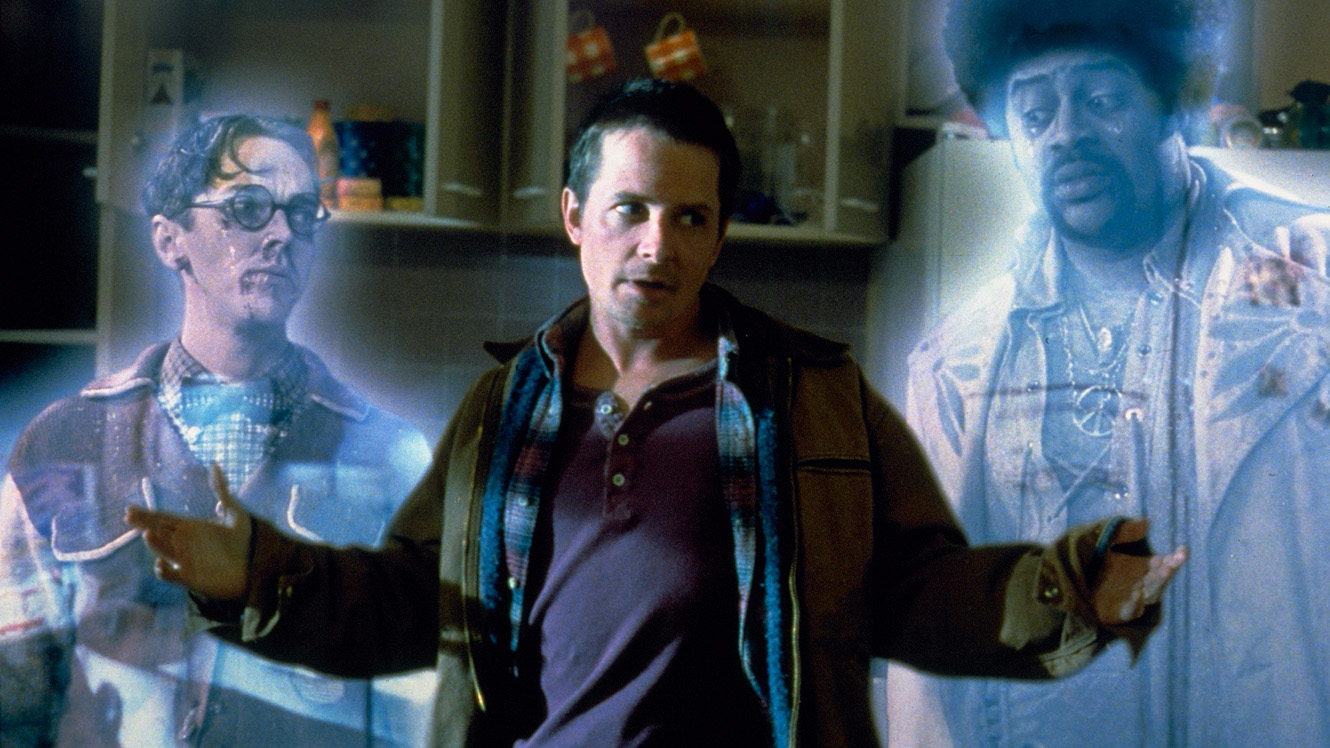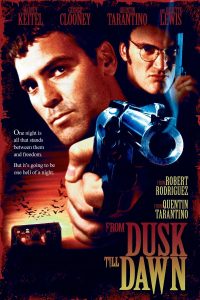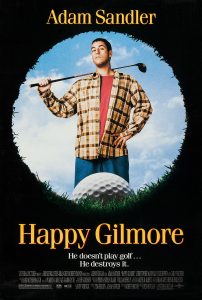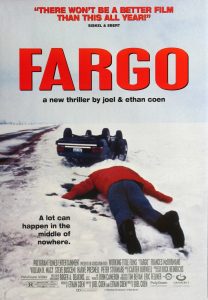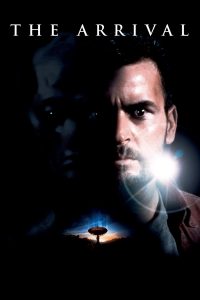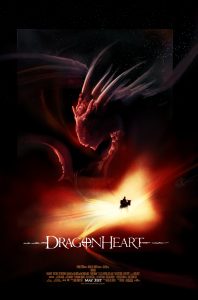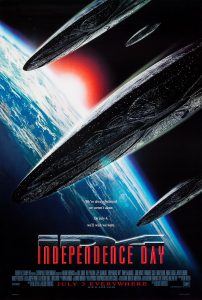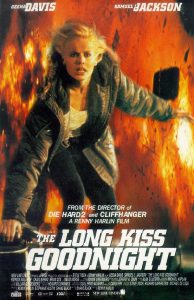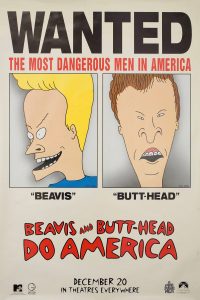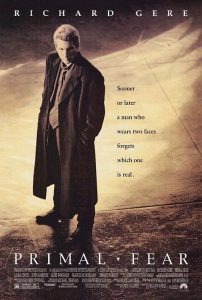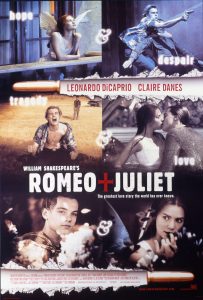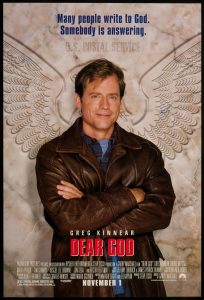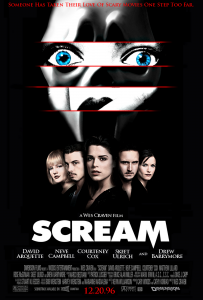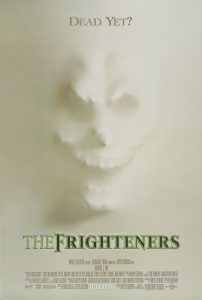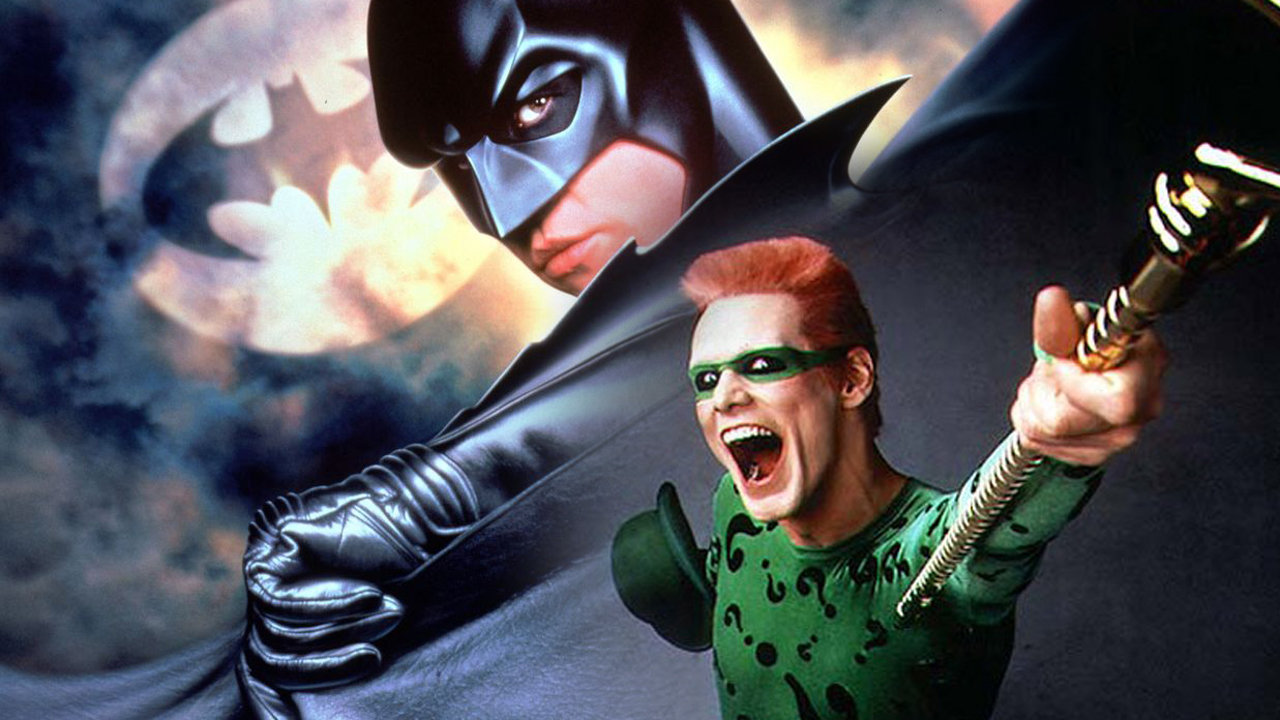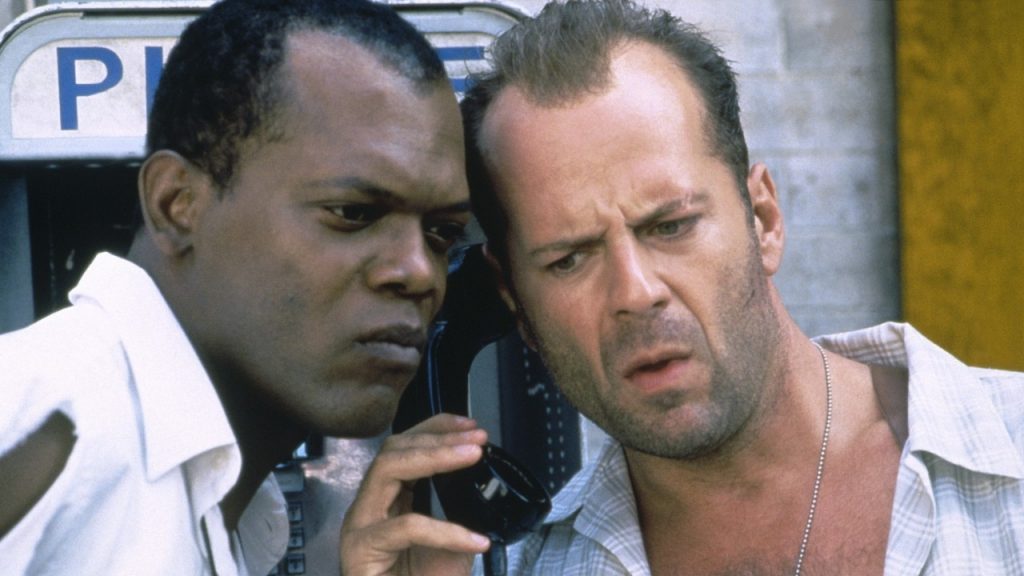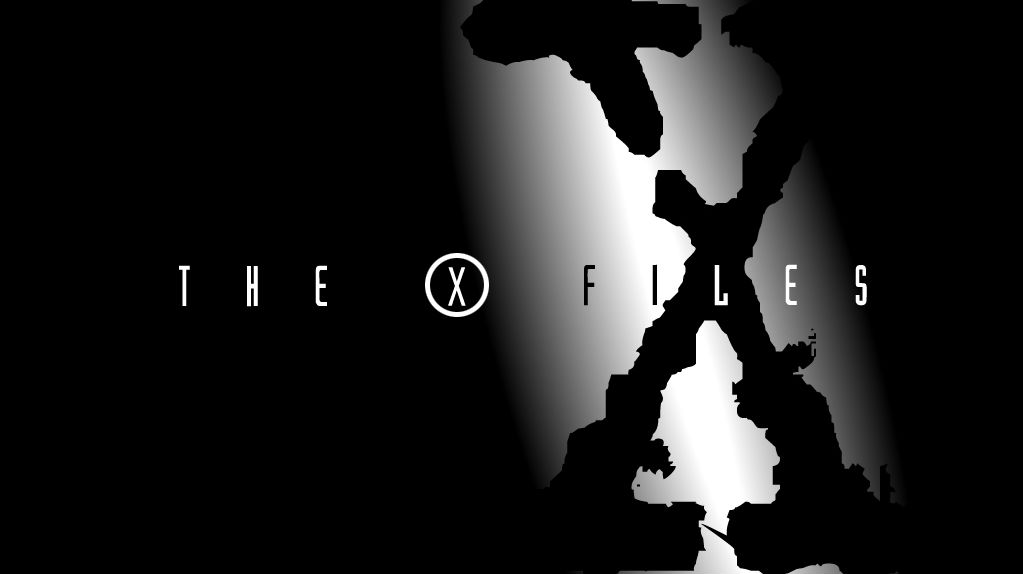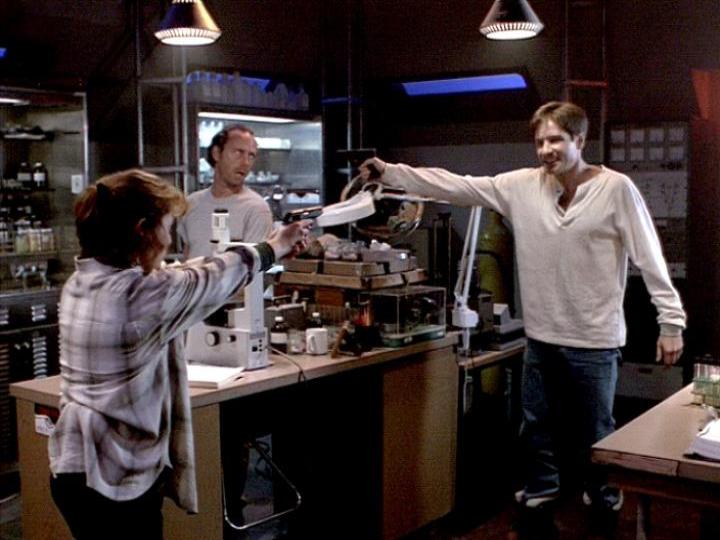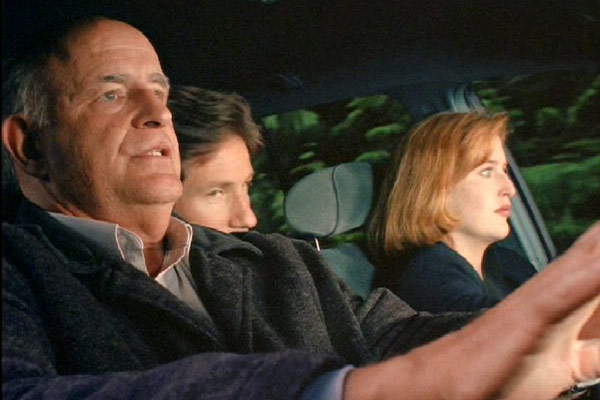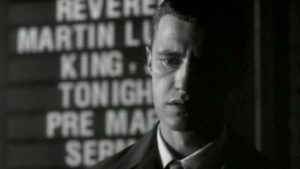College, Round One
We’re looking at some changes in format for this entry, because 1997 was a big year. Make sure to stick around after where the credits usually roll – because this is a Double (even possibly Triple) Feature entry.
The Schlock
Starship Troopers
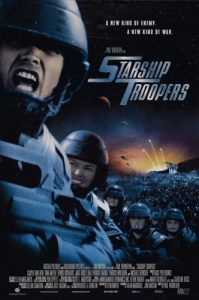
Rating: ★★★
When I Saw It: 1997
What It Gave Me: Tons of Great Effects To Chew On
Johnny Rico (Casper Van Dien) is a rising star in his high school class. As a member of a rich and influential family in Buenos Aires, he knows that he could live a good and long life with little hardship. If he wants any say in his society though – if he wants to vote or hold office – he’ll have to serve four years in the military as a Starship Trooper to earn that privilege. He wants to be more than just a bystander in his government, so he signs up for service. Shortly after, Earth comes under attack by an alien race known only as ‘The Bugs,’ and he is sent out to war on the front lines of the Bugs’ home system. Along with several of his high school friends, now also Troopers, he learns the terror of war and the price of citizenship.
This movie is… not good. At least not when you hold it up to the book by the same name, written by Robert Heinlein. The book is about much, much more than going to interesting planets, discovering fascinating aliens, then killing them. It’s about civics. It’s about duty. The film gives that some lip service – but, mostly it’s about killing Bugs. It fits the director, Paul Verhoven, though. This is the same guy who puts up his film Robocop (1987) (an admittedly beloved movie for me) as a Christ story (I seem to recall fewer brutal shootings committed by Christ’s direct hand in the Gospels).
It does however excel in a couple other ways. The first was the special effects side. Looking back now, the effects are okay. In 1997 I remember coming out of the theater on Front Street with my friends and being completely jazzed. This was what we were going to school for: to learn how to do the spectacular animation work we’d just seen on screen. My friends and I spent a lot of time reading magazine articles and scouring the web for tidbits on how to replicate the effects. It was a wonderful rabbit hole to dive deep into.
Another great aspect was that it brought back Doogie Howser. I mean Neil Patrick Harris. Not that he ever left, really. It’s just that Doogie Houser M.D. (1989-93) was largely remembered as a joke by most of my friends at that point. By the time he shows up as Intelligence Officer and psychic, Carl Harris, in Starship Troopers, he’d managed to grow up enough to shake off the typecasting and start climbing the ladder to bigger and better things.
Lastly, this film may have missed some of the messages of the original novel, but it did get propaganda right. ‘Would you like to know more?’ is still cited around the gaming table or among friends to this day. Usually accompanied by the mental picture of a Bug getting a probe right up the wazoo.
Face/Off
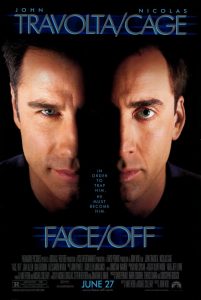
Rating:★★★
When I Saw It: 1997
What It Gave Me: Great Running Action Sequences
Castor Troy (Nicholas Cage) is a notorious terrorist. Sean Archer (John Travolta) is the FBI Special Agent who brings him down. There’s still work to be done though, and Castor’s brother, Pollux, knows where the next strike is going to take place and how it all will go down. Pollux is in custody, but doesn’t know where his brother is, leaving him vulnerable – but not entirely. The only person the feds know he’ll talk to is Castor. Fortunately for Sean, there’s a ‘highly experimental’ (read: plot-convenient) surgical process that may give him an opening. Sean and Castor have the same build, and with a little pseudo-science, they transplant Castor’s face onto Sean’s in the hopes that Archer can go undercover in the supermax black-site prison where Pollux is being held to get what the feds need from him. Unfortunately, while Archer is on assignment, Castor gets loose and forces the staff to place Sean’s face on him. They both assume each other’s lives and go after each other in a cat-and-mouse style arrangement after that, with a trail of explosions and dead bodies that follow them.
You have to put aside things like medical science, consistency, plot loopholes, reality for just a second, now. It’ll be waiting for us when we get back, I promise.
The reason this film makes the list is its Director. John Woo was the man in the big chair. This is the guy who made some little films from Hong Kong you may have heard of, like A Better Tomorrow (1986), The Killer (1989), or Hard Boiled (1992). This guy does action well. His style is singular (watch for the doves). If you wanted Chow Yun Fat at his pre-American best, you watched him under the direction of John Woo. That’s what Woo brought to Face/Off. He manages to take an almost entirely impossible premise, then sells it. The actual acting parts are overwrought by Travolta and Cage, but man-oh-man are the fights good. Good enough at least to forget the really obvious problems with plausibility and the entirety of medical science.
Event Horizon
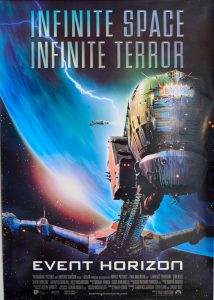
Rating: ★★★
When I Saw It: 1997
What It Gave Me: An Unreasonable Amount of Terror and Unease
In our first pioneering steps into the great void of our cosmos, we sent out a ship. It was called The Event Horizon, and it was fitted with an experimental travel system. Through insanely complex physics, the technology involved would ‘fold space’ in such a fashion that two corresponding places would be connected and a hole punched between both, making a gate the ship could fly through to cross great distances. The ship made its maiden jump successfully insofar as it went into the gate… but never came out again. Until now. When The Event Horizon suddenly reappears years later, a survey crew is sent out to investigate what happened and to piece together the mystery of where it went and why it came back now. When they find out where the ship has been… things do not go well for the crew. See, the ship was travelling through an alternate dimension that could best be described as hell. It might even have been the actual hell. And, when the ship returned, it brought back a little hell with it.
This is another one of those films that made an impression, but comes with a few caveats. While this film is good, and the premise sold me, and it’s well executed, I cannot wholly recommend it. I am not entirely averse to graphic violence. I don’t have a huge tolerance for gore, but I can stomach most things. This was on an entirely different level of magnitude and it struck me on several truly uncomfortable levels. It is not for the faint of heart. While I liked this film, I am unlikely to return to it any time soon. This is the kind of film you probably only need to see once.
Somewhere In the Middle
Chasing Amy
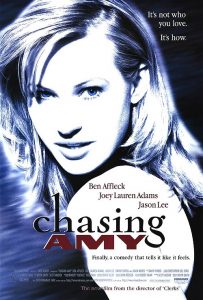
Rating: ★★★★
When I Saw It: 1997
What It Gave Me: Massive Love Complications
Boy (Ben Affleck) meets girl (Joey Lauren Adams), boy falls in love. Girl is a lesbian, but turns out to be a great friend. Boy can’t keep feelings inside, boy manages a strained romantic relationship with girl while alienating Boy’s best friend (Jason Lee). Personal histories come out, tempers flare. Love gets really complicated.
The above is an oversimplification of course. But let’s be honest, romance plotlines are typically variations on ‘x’ meets ‘y’ and then something romantic happens (successfully or not) while other factors make life interesting for both. In the mainstream, x is usually the girl, and y is usually the guy (just like in genetics!). And this really didn’t deviate from a boy meeting a girl, but it made it a hell of a lot more complicated than what mainstream romances typically did in the nineties.
In traditional Kevin Smith fashion, he didn’t waste a lot of time getting the audience into the topic of sexuality up to your elbows while also making his prerequisite dick and fart jokes. The film really showcases all involved parties as more than just a cardboard cutouts or tropes. Anyone who has been in love can tell you that while there’s a lot of great things to come out of it, it’s also a raw nerve for a great number of people. This film is fully populated with raw nerve characters.
I remember the film making some of Smith’s ardent fans uncomfortable at the time. It was a noted departure from his surreal comedies, which I suppose his fans weren’t entirely wrong to have expected or wanted. I didn’t feel that way. As a fan of his from the beginning of his career, I feel that Chasing Amy is one of his great films. It did great at the box office (which Smith needed after Mallrats (1995) experienced a box office flop) but its diversion from the over-the-top wacky antics of Clerks (1994) or Mallrats (1995) left a bad taste in some Smith fan’s mouths. Their loss, I suppose.
Austin Powers: International Man of Mystery
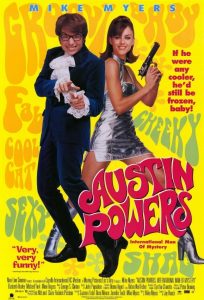
Rating: ★★★
When I Saw It: 1997
What It Gave Me: Lots of Laughs; A Thorough Mocking of the Sixties
Speaking of the expectation of goofy comedies, 1997 definitely got one in the form of Austin Powers: International Man of Mystery. Austin Powers (Mike Myers) was the best British superspy of the Sixties. When Powers thwarts his nemesis, Dr. Evil (also Michael Myers), the mad doctor is placed in suspended animation. Powers, the only man to truly know and defeat Dr. Evil, also goes into stasis as well should his archnemesis return. When Dr. Evil is retrieved by his henchmen in 1997, the British Intelligence Service retrieves Powers as well, and the hunt begins.
This film is a no holds barred spoof of every James Bond and James Bond knock-off film ever made. It additionally adds in a scathingly mocking portrayal of the sixties versus the (then) present day. When you sit down to look at it, it very much took the tack of Scream (1996) in some ways. AP:IMoM readily shows all of the plot holes, inconsistencies, and sheer bad ideas ever to grace the genre of Sixties and Seventies Spy films through several great scenes (the best one being the one with Dr. Evil’s son, played by Seth Green).
Beyond Wayne’s World (1992), Myers often falls flat for me. He really does well though in this film by playing both the hero and the villain. You can also probably stop here. There’s more movies after this one, but they feel a little too much like the franchise has beaten all it can from a long dead horse.
Contact
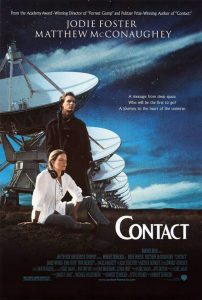
Rating: ★★★★
When I Saw It: 2017
What It Gave Me: A Decent Thought Experiment
This is a film adaptation of the novel Contact, by Carl Sagan. A signal is received by a young scientist (Jodie Foster) that is revealed to be extraterrestrial in origin. When analyzed, it reveals a complex set of instructions that details the creation of a vast machine, presumably meant to transport one human passenger to an uncertain destination. Faith and science both have things to say about the device, it’s potential, and how to best use it or not use it. Once a plan of action is determined, the human race marches toward whatever mysteries the device holds to tell us more about life beyond our own planet.
This movie got a lot of flak from people. Some complained about the length of the film (150 minutes), yet the same people sat through Titanic (1997) (194 minutes) which bored me to tears and made my butt numb. Another reason might be that the film spends most of its time waxing philosophical about what the signal means for the world. There’s a lot of conjecture about aliens instead of something flashier, like the mega-invasion in Independence Day (1996) that came just a year before it.
It sounds snobbish I guess to say that this was a film made for the more cerebral set, but we’re talking about a film based on the writings of Carl Sagan. Cerebral was guaranteed given Sagan was a genius and a visionary. I guess people just want to see people blow things up more than they want to see a movie about peaceful contact by benevolent aliens. It’d explain Michael Bay.
Gattaca
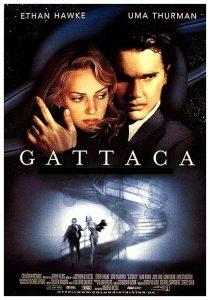
Rating: ★★★★
When I Saw It: 1997
What It Gave Me: Another Good Dystopian Setting (That Could Be Real Soon)
An ‘in-valid’ (Ethan Hawke), naturally born without genetic enhancement, struggles to be exceptional in a world where perfection is measured by your genetic engineering. Sickly and disadvantaged, he grows up alongside his ‘valid’ genetically modified brother. While his brother excels based on no other merit than his ‘perfect’ genes, Hawke chafes in a society that does not value him despite his intelligence. Undeterred by his social ostracization, he comes up with a plan to excel using the genetic material made available to him by a ‘valid’ who was crippled. Hawke is determined to get to Titan, a moon of Saturn, using his stolen ‘valid’ blood, urine, and hair samples. Once he gets there, he figures he can show everyone just how valuable ‘in-valids’ can be.
Gattaca wasn’t particularly well received by me the first time around. It should have been. Further views got me on board though. The cast is good between Ethan Hawke (who I’ve liked since seeing Dead Poet’s Society (1989), Uma Thurman, and Elias Koteas.
Furthermore, I remember the whole concept of eugenics at that level being in the realm of flights of fancy; an interesting and plausible idea that we were dozens of generations away from (no matter what futurists might say). Now, we live in the age of CRISPR. Gattaca is catching up faster than I would have given it credit for. It feels less like a science fiction fable now, and more like a cautionary tale.
Anastasia
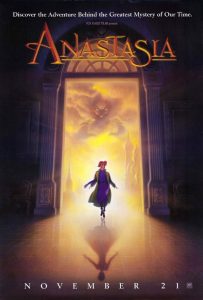
Rating: ★★★★
When I Saw It: 1997
What It Gave Me: More Great Animation Magic
A fictionalized story of the Romanovs is presented in this Don Bluth animated film. In particular, it details the life of the lost Grand Duchess, Anastasia Romanov. When the Bolshevik’s overthrew her Tsar Nicholas’ rule in Russia, all the Romanovs were killed and their bodies retrieved, save for Anastasia’s. There are rumors though in St. Petersburg that the lost daughter of Tsar Nicholas was not killed. In fact, she’s said to be living in the city, her true identity unknown to even herself. Anyone who could find her and return her to her grandmother in Paris would stand to make a fortune. In fact, Dmitri (John Cusack) and his partner (Kelsey Grammer) are looking to claim that wealth. They’ve found a young woman (Meg Ryan) with no memory of her childhood who they think can serve as a ringer for the unaccounted for scion of the Romanovs. However, it turns out she really is Anastasia! Furthermore, Rasputin (Christopher Lloyd) is not actually dead. He yet lives through necromantic magic, seeking to crush the last remaining Romanov.
The story in and of itself isn’t much to write home about. The voice performances were well done and involved a lot of great cast (including the voice of Rasputin’s animal sidekick, Barktok, played by Hank Azaria). But, that’s not where Anastasia gets my admiration.
What stood out in this was the traditional animation and the way they managed to seamlessly work in computer animation alongside it. 3D and traditional animation had been married well before this film by Walt Disney’s Animation Studios and a handful of others. However, this did it in a way that really sat in the background through subtle compositing. The best example can think of is the scene in which Anastasia sings ‘Once Upon A December’ and imagines what the life of the Tsar’s palace must have been like. You get this wonderful combination of several separate animations and a partially computer designed background.
Bluth’s former pictures had not been particularly known for this kind of approach, and his studio’s films hadn’t really changed all that much since films like American Tail (1986), The Land Before Time (1988), The Secret of NIMH (1982), or All Dogs go To Heaven (1989). Bluth’s studio stuck with traditional cel animation and had taken a beating as other studios like Dreamworks and Pixar (who had the capital) went on to more tech-heavy productions. Anastasia was their first foray into digital, and it made an impression. Between the 3D techniques they employed and the use of a color and shading program called Toonz (previously employed in the film Balto (1995) by Universal), they created a work that far outshone their previous films. Bluth’s studio would only go on to do a few more films, but those films had finally caught up with their competition in terms of technical savvy.
Good Will Hunting
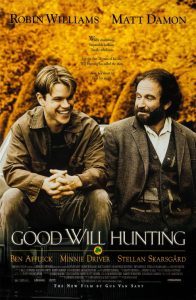
Rating: ★★★★
When I Saw It: 2017
What It Gave Me: An Example of Putting Yourself In the Work
Will (Matt Damon) is troubled young man with a lot of personal issues. He lives in Southie, a collection of South Boston neighborhoods that have hit the skids for a long time. He spends most of his time there with Chuckie (Ben Affleck) and their fellow childhood friends. They all drink beer, get into fights, and work a variety of blue collar gigs in order to keep what little they have. Underneath it all, Will has a hidden gift for all stripes of academia that he keeps from his friends. That gift is recognized by one of Harvard’s mathematics professors after Will is caught solving an almost impossible formula on a public blackboard while working as a janitor. Soon after, Will instigates an altercation that turns into a multiple assault brawl and an arrest. He’s bailed out by the observant professor under the provision that Will seeks counseling alongside his academic pursuits. After going through the best of the best, the doting professor sends Will to his college roommate (Robin Williams) who is himself a guy from Southie. Together, Williams and Damon go through his inadequacies, his fears, and, ultimately, his place in the world.
I’ll admit, I didn’t give a shit about this film while I was in college. I had big special effect movies to pick apart. Dramas generally weren’t something I was willing to spend a hell of a lot of time on. I’m a lot mellower now and my wife and I watch a variety of films and television programs. Most still bend to the fantastical, but since I started this series, I have been catching up on the films that I probably should have caught the first time around. I was greatly pleased by this film in my efforts to catch up.
For all of the shit that you hear people give both of these actors, Damon and Affleck are amazingly good acting alongside one another. This is no surprise since both are actually kids who grew up in Boston. They wrote the film, and a lot of the underlying content is autobiographical (if somewhat altered) which gives it some punch. They really bring out the best of their capabilities in this film. When you add in Robin Williams playing a dramatic role as he did in Dead Poet’s Society (1989), the film builds a head of steam that can’t be stopped.
It’s also worth noting a great scene in which Will is asked why he shouldn’t want to work for the NSA. It’s freaking amazing.
Personal Blockbusters
Men In Black
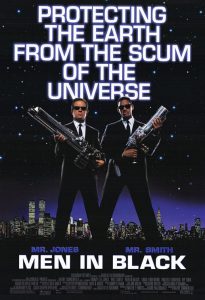
Rating: ★★★★★
When I Saw It: 1997
What It Gave Me: The Lighter Side of UFO Conspiracy
Aliens are on Earth and living among us. We’ve known about them for a long time, and we’ve developed an understanding between the rest of the universe and the few people who are in the know. We hide the existence of these aliens to avoid widespread panic and give certain allowances to sensitive alien visitors looking for an out of the way place to live. In exchange we gain closely guarded alien technology to keep up the charade and pay for the Men In Black program that maintains the conspiracy by patenting said technologies. Everybody wins – mostly. Jay (Will Smith) learns of the MiBs after running down a hard to catch alien and is recruited by Kay (Tommy Lee Jones) to help protect Earth from the worst scum of the universe.
This film crept up on me. It was heavily marketed, but I was so damn busy at college I hadn’t hardly looked up from my pegboard and lightbox long enough to catch a commercial. My dad took me to see it at this new place they’d built in Brandywine called Funland: a three story building that hosted parties, laser tag, a full arcade, mini-golf, and a sixteen cinema theater. It was goddamned heaven. With the X-Files now in full swing, government conspiracy and alien stories were peaking. This film added a layer of humor and special effects magic to great performances by not just Smith and Jones, but also from Linda Fiorentino, Rip Torn, Vincent D’Onofrio, and Tony Shalhoub.
The Postman
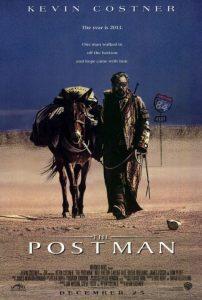
Rating: ★★★★★
When I Saw It: 1997
What It Gave Me: Just Enough Post-Apocalypse
The world as we know it is history. There was a global war, and the skies went dark for three years after a limited nuclear and biological exchange. When the sun finally came back up over the horizon, civilization was all but gone. America and all of the other superpowers were no more. In the remains of our society, only the strong survive. In the former American west, The Holnists rule through intimidation and military might. They may not have the weapons of the past, but what they do have is enough to make everyone in their territory fear them enough to conscript their children and pay them tribute. After escaping the Holnist Army, a drifter (Kevin Costner) comes across a the skeleton of a postal worker who was carrying a sack of undelivered mail when he died. The drifter takes the uniform and the mail, then begins to use it to con settlements into letting him in their walls. His story is that the government back east is back, and that he’s bringing their mail (better late than never) with more to come in the future. He builds up a reputation from the con and eventually causes people to gather to his phony cause of a restored United States. This brings down the wrath of the Holnist Army, and he soon becomes a patriotic figurehead he never knew he wanted to be.
I love post-apocalypse films. This one isn’t as grim and gritty as, say, the setting of The Terminator (1984), or The Matrix (1999), but it’s good. And by good, I mean believable. The settlements look just like they’re supposed to: unplugged and more than a little run down. You can still get power – usually by a generator hooked up to some kind of burnable fuel. You might even have running water if you have close enough access to something clean enough. Horses are again the best way to travel long distances. Barter is the rule of the day.
The film runs toward the sappy and somewhat melodramatic, but there’s still a lot to like. It’s book by the same name (written by David Brin) has a bit more depth to it. The film adaptation has a lot of heart, however. Two of the better reasons to watch the film are the villain played by Will Patton, and Ford Lincoln Mercury, played by Larenz Tate.
The Fifth Element
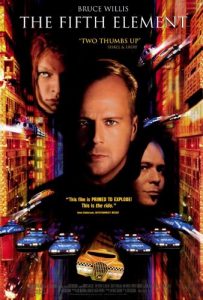
Rating: ★★★★★
When I Saw It: 1997
What It Gave Me: A Visually Brighter, Yet Tonally Darker, Future
In the twenty-third century, Earth is home to billions upon billions of humans, and there are even more of us living across the entire galaxy. We live in general peace with our galactic neighbors, and everything seems fine until Evil (yep, that’s it’s name) awakens in the depths of space. Evil begins to home in on Earth at great speed. When it arrives there, it will wipe out not just all human life, but all life. It’s chosen Earth to destroy first because the Ultimate Weapon that can stop it was hidden there by a wise alien race in the early 1900’s. If it can destroy the weapon, nothing will keep Evil from quieting the entire universe. Korben Dallas (Bruce Willis), a special ops legend, is reinstated from civilian life by Earth’s government to aid a priest (Ian Holm) who knows the secret to the Ultimate Weapon. It turns out that the corpse of a woman was the Ultimate Weapon, and they rebuild her (Milla Jovovich) in a lab in order to defeat Evil and its minion, Jean Baptiste Emmanuel Zorg (Gary Oldman).
This film was billed as ‘Star Wars for the nineties.’ It’s not, but it is fantastic, regardless of its marketing hype. This was my first introduction to Luc Besson, and it’s launched a general appreciation of his work since. Anything he touches, I’m open to viewing just based off of the strength of this film. He managed to pull off a wonderful visual style for the future that still holds up remarkably well. It’s a riot of colors in a genre where the future is often not so bright. It brings whimsy to an outer space setting that typically feels hard and cold in other movies in the same vein. It’s funny and touching and totally bananas. Yet, it’s also violent and dark at times. Society is united, but also not necessarily great. Everyone in the cast does an amazing job, even the side characters like Ruby Rhod (Chris Tucker) and the President of Earth (Tommy Lister)
The Game
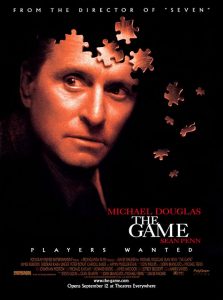
Rating: ★★★★★
When I Saw It: 1997
What It Gave Me: What A Proper Mindfuck Looks Like
Nicholas Van Orton (Michael Douglas) is the very image of success. He is a successful business man, lives in a beautiful home, and has access to the finest country clubs and restaurants. He wants for nothing. Sure, he has a failed marriage and a brother Conrad (Sean Penn) who is in and out of rehab. Sure, he lives alone with only his maid as his regular human contact. Sure, his dad committed suicide on his birthday when he was a young child. But he’s comfortable. He has no wish to rock the boat. He’s content to live a life of privilege away from others. Then, Conrad swings by with a birthday present. It’s an invitation for a game. Conrad tells Nicholas that he’s played it before and it changed his life. Eventually, Nicholas agrees and goes to the offices of the game’s provider, Consumer Recreation Services (CRS). They put him through a battery of tests ranging from the innocuous to the deeply psychological under the pretense that it will help them customize his own personal game experience. His game begins when someone leaves a clown marionette in his driveway. After bringing the clown into his home, his television speaks directly to him and he retrieves a key from the clown’s mouth. He’s given little other information by the television apart from the fact that his game has begun and the key is important. And then the real oddities start piling up. Old friends seem to turn on him or go strange. Elaborate pranks and ‘coincidental’ accidents occur. Soon, the events surrounding him become more sinister and he begins to see CRS everywhere. Eventually, he comes to learn of a conspiracy that ties everything together through his mysterious game, and his life spirals way out of his control. Who are the people who run the game? What do they really want? Can Nicholas uncover enough to come out alive?
This is how you fuck with people.
It’s directed by David Fincher, a personal favorite of mine who also directed Seven (1995) and Fight Club (1999). His visual style and thematic presentations outline the titular ‘game’ as it events grow from simply intriguing to the lethal. The paranoia sets in from the moment Nicholas begins taking the test and reaches through every character interaction. By the time you’re a third of the way through the film, the paranoia becomes infectious. Everyone’s in on it. They have to be. How else could you get so thoroughly into someone’s life? The movie basically keeps you guessing until the film’s climax (which I have some trouble with admittedly). Your brain will not be able to shut off while you watch everything unfold.
While it’s not as crazy as the climax of the film, there’s a great scene that really drives across the feeling of total violation when Nicholas returns home to a vandalized home. The walls are lit by UV lights and fluorescent graffiti scrawls and plastered messages mock him, preying on his inadequacies and revealing his deepest fears and secrets. As he continues through the home, White Rabbit plays in the house louder and louder as he finds that whomever is coming after him has left police photos of his father’s body from the day he committed suicide. It’s the first time he shows true fear in the film. Truly chilling stuff.
The Devil’s Advocate
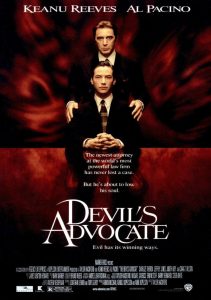
Rating: ★★★★★
When I Saw It: Circa 1998
What It Gave Me: Theological Horror, A Better Devil
After successfully defending an accused child molester (who was guilty as hell), Kevin Lomax (Keanu Reeves) gains the attention of a New York City law firm. They headhunt him and bring him into the influence of John Milton (Al Pacino), the head of the firm. Milton lavishes Kevin and his wife, Mary Ann (Charlize Theron), with a king’s welcome. He gets the great digs in Manhattan, a huge salary, a corner office, and immediately assignment to some… interesting trials. Not long after, his long hours begin to destroy his relationship with Mary Ann. Mary Ann has trouble adjusting to the new lifestyle as she feels increasingly judged by her new circle of peers. Then she begins to have gruesome visions. Her new ‘friends’ writhe with demons beneath their skin, and she sees an infant playing with her own severed reproductive organs. As odd events and potential seeds for marital infidelity occur, both Kevin and Mary Ann begin to suspect something sinister at play. It seems that John Milton is behind everything going wrong. Oh, and that Milton is the Devil himself.
While I’m not a religious man, I like theological horror. When you’re talking about the devil, it’s hard to get the balance right. So often, the devil is an almost farcical or even a cookie cutter villain. He is the kicker of puppies… because reasons. He’s the guy who shoves people in front of buses for kicks. It’s so easy to portray the devil as a simple foil because he’s just evil by nature. It’s easy to just make him an archetype and be done with it. Not so in The Devil’s Advocate. The Devil has an agenda here. He has what he feels just cause to be angry; he has motivation to both push men toward sin and to do evil himself if it’s called for. The devil comes across as nuanced, experienced, calculating, and methodical in this film. I don’t think anyone else has quite pulled off a portrayal of the devil quite like Pacino does here.
The film also has wonderful visuals as well, and they don’t skimp on horrific imagery. Yet, the gore presented is momentary. They don’t slather it on so much as they give you just enough brief glimpses for your mind to fill in even more horror than what is presented. The swirling sinners in the stone work and the sinuous demons waiting beneath the skin of Milton’s minions leave enough vagary to conjure up even more unsettling ideas in the imagination. The effects seem a little dated now – but they manage to pull off just enough to leave an impression even by today’s standards.
Grosse Pointe Blank
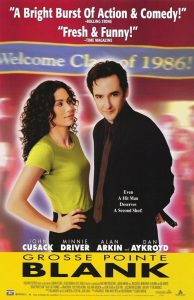
Rating: ★★★★★
When I Saw It:
What It Gave Me:
Martin Blank (John Cusack) is a professional killer. He’s good at his job, but he’s growing more and more distracted and dissatisfied with his work. After a run in with rival assassin Grocer (Dan Ackroyd) and botching a job for a client, he decides to take a trip back home. Not only is there a job there waiting to be done on behalf of his pissed off client, but it’s also the weekend of his high school reunion for the class of 1986! While he’s there, he reconnects with his old flame Debbie (Minnie Driver), and grapples with the existential crisis that his life has become.
The film’s population of misfits is peopled with a perfectly curated cast. In addition to the leads played by John Cusack and Minnie Driver, you have Doctor Oatman, Martin’s terrified psychiatrist, played by Alan Arkin. You get Jeremy Piven as Paul Spericki, Martin’s best friend from Grosse Pointe High. You also get Hank Azaria as a government spook trailing Martin, and to sweeten the pot, Joan Cusack plays Martin’s high energy assistant who runs his empire of death. It’s probably one of the best assembled group of actors I’ve ever seen. They may not all be headliners, but the chemistry they have is amazing. I’d probably give an eye tooth to have had the opportunity to see them filming this behind the scenes. It had to be a blast.
The soundtrack is also pure bliss for me since I grew up not only in the nineties, but also the eighties. It runs the gamut of great period music from The Specials, Guns ‘n’ Roses, the Violent Femmes, The Clash, Echo & The Bunnymen, The Jam, The Pixies. I could go on, but it’s a huge list. Too big to get into here. The collection for either of the two soundtracks are one of those great examples of CDs to just pop in and set to repeat. You could do worse.
And then there’s the writing. This has to be one of the most quotable films I think I’ve ever seen. It comes up everywhere I go since the movie has a broad kind of appeal for a lot of my friends.
The really curious thing to me is why there’s not more work by the film’s director, George Armitage. Armitage has few directing credits to his name on IMDB, and most of them seem to be exploitation flicks, TV movies, and one action film before making a handful of films like Grosse Pointe Blank, Miami Blues (1990), and The Big Bounce (2004). After that, like Keyzer Soze… poof, he’s gone. He hasn’t directed another film in thirteen years as of writing this in 2017. Come back, George. If you have another Grosse Pointe Blank style hit in you, I want to see it. The world needs to see it.
Triple Feature: The Special Edition Star Wars Films
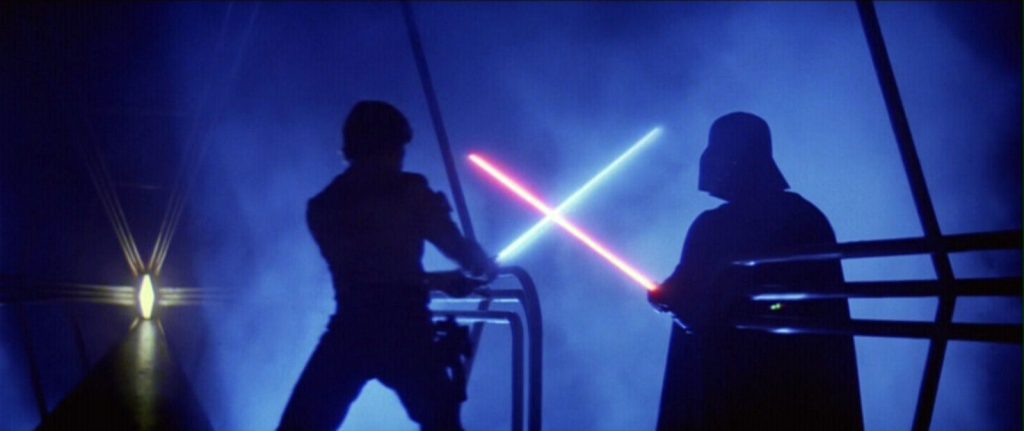
The keen eyes among you may have noted an omission here. It may have seemed like a million voices cried out at once in something like elation and rage mixed together. It would have felt like a ripple in some universal force which guides us all and binds us together.
No. I have not forgotten the re-release of the Star Wars Trilogy. And 1997 was one hell of a year for Star Wars.
There’s a good reason I haven’t rated these films – as far as I am concerned, Episodes IV through VI of Star Wars are from the years 1977 (Star Wars), 1980 (The Empire Strikes Back) and 1983 (Return of the Jedi). These films were known quantities save for the scant bits where Darth Lucas opted to make a few tweaks. By technicality, they aren’t really Nineties films so much as older films with tacked on footage. For the sake of argument, the originals are all five stars. I’d give them more actually. There’s a rating system I’m adhering to, though. So, five stars.
As for the re-releases, well, you have to really look at what they changed before you can sufficiently quantify any inherent goodness. But, we’ll get to that in a moment. Right now I want to tell you how it felt to me when the films were brought back to the big screen.
The Experience of the Second Coming of Hamill
The news of a re-release of the Star Wars Trilogy in 1997 was not secret. Once it was announced in mid 1996 that not only would the Star Wars films return to theaters (one a month starting in January and ending in March), but each film would be fully restored and have new material added! George Lucas wanted to take advantage of emerging visual technologies to add in new elements to enhance his original work. Considering how he’d collaborated in the great hits of my youth (Star Wars IV through VI and the Indiana Jones Trilogy), I was greatly anticipating bonus footage.
Well, it turned out to be a mixed bag.
Millions of loyal fans and new generation of Jedi worshippers came out to the theater to see it. And at first, it was glorious. The film was really cleaned up. Everything looked so much more amazing on the screen. My dad had told me for years that until you saw first scene in Episode IV on the big screen – the one where Princess Leia’s (Carrie Fisher) Corellian Corvette is being chased by the Star Destroyer – you ain’t really seen it. And he was right. I was struck anew with awe and love for the films. I loved seeing the expanded port of Mos Eisley as Luke (Mark Hamill), Ben (Sir Alec Guiness), and the droids move toward their destinies. There were neat aliens, more jawas, more Star Wars. I loved it.
Then, we meet Han Solo (Harrison Ford) and everything is going well. Greedo and Han are verbally sparring and then… what? What?! WHAT THE FUCK? Greedo takes a pot shot at Han before the footage we all know takes over and the film continues.
My mind screeched to a halt. I thought to myself, ‘that’s not the way it goes! That… that’s not my movie! What did you do that, George? WHY WOULD YOU DO THAT?’ Admittedly, it didn’t take priority for that long – there was still more of A New Hope to go. And most of the changes were good in Episode IV. Except for that one. That one, near-total-movie-ruining shot. I had a reduced enthusiasm after that for the remaining films – but not by much.
A month later, Empire was re-released in February (because rebellion is for lovers), then Jedi followed to close it out in March. None of the other films had anything nearly as jarring as the Cantina Shooting, and I could deal with most of the remaining edits (I loved some of the edited shots of Cloud City in Empire). A lot of people are glad the original Yub Nub Ewok ending was pulled from Jedi and replaced by shots of a Victory Celebration on Coruscant (the home base of the Empire). I’m not one of them – I felt the original ending was okay, but I don’t really care about the location so much as how they’d later put in young Vader (Hayden Chrstiansen) next to Ben Kenobi.
But, Greedo. Greedo is still a sore spot for a lot of people. Followers of the Scoundrel did not take kindly to Han Solo being reactive. The original Han was not exactly a good guy. Le was a Lancer (per the definition at TVTropes.org). He was a smuggler in illegal goods, and he had a dangerous reputation. He was the dark to Luke Skywalker’s light. You need that dynamic, because Luke eventually pulls Han Solo up from the pit of criminal ambiguity and into the cause of the just. It works that way, and we grew up with that version. Even if you couldn’t have voiced it then, you can certainly see it now. At least that’s how it worked for me.
George Lucas instead claims that Solo was always meant to be John Wayne, but if that was the case… why didn’t you have him act like that before? It would have required near to zero effort to shoot it that way in 1977. Just one more blaster shot. It feels more like Lucas made a change to satisfy a film rating issue (a shooting like that would probably bump them to PG-13 in 1997), or to soften his image for the benefit of children. Regardless of the case, we’re stuck with it. It is now almost impossible to get the original cut of the film, particularly on DVD. Darth Lucas declared the scene as canon. He has altered the deal, and we should pray he does not alter it further.
Thankfully, he’s unlikely to make any further changes. Disney now dominates the destiny of the franchise. Rumors continue to circulate though that we’re going to get un-Lucased prints of the original trilogy soon from the Mouse House, but they always prove to be unfounded. Lucas himself claims that the remaining original prints are too old to be salvaged… but I find his lack of faith disturbing).
Now, on the side of the Devil’s Advocate, I also understand one thing as a creative. My work, my vision. Technically speaking, we don’t get to judge him. This was his baby, his magnum opus. In 1997, Disney wasn’t telling George to do anything. He owned it, lock, stock, and barrel. And honestly, if I go to make changes in my work, I’d feel justified too. Art isn’t something you ever feel is complete so much as you abandon it. This is a paraphrased sentiment of not only Lucas, but from others in the past as well. He felt there was room for improvement – even though, in many people’s opinions, he’s wrong.
It’s a thorny quandary for any aspiring nerd looking to make great fiction. Maybe someday, I’ll have to make it too.
A Report Card of Change
So, we all know that there were changes to the original trilogy, but what of them? How did they rate? Well, let’s look at the highlights, shall we? I’m sure we missed some stuff. And, I’m sure I’ll hear from you to let me know what I missed.
Star Wars Changes
- Expanded entry into Mos Eisley (Good) – More everything! More Jawas, more weird stuff! This was all pretty cool! I was really taken with this great montage of Mos Eisley in its full strangeness.
- Jabba In Docking Bay 94 (Indifferent) – Some people trash this edit, but it’s not a big deal for me. You can make the claim that the scene is dramatically unneccesary, or that the scale of Jabba is obviously off. And, yeah, the squeak shot where Han steps on Jabba’s tail is a terribly obvious edit given how video editing can be done now. But, at the time, it legitimately seemed like magic. If somewhat imperfect magic.
- The Cantina Shooting (Bad) – We covered this. This is an abomination to both me and any gods that may or may not exist. Han. Shot. First.
- Yavin IV Updates (Good) – You can see more of the rebel base on Yavin when the Millennium Falcon lands, which I thought was cool.
- Biggs Darklighter and Luke Skywalker Reunion At Yavin IV (Good) – I can see why the footage of Luke and Biggs meeting up before the Battle of Yavin was dropped. It’s not needed, but it adds a little flavor. It shows that Luke is connected to the larger world around him, no matter how isolated he was on Tatooine. It doesn’t mess up the film’s pacing for me, which was the reason it got dropped in the first place by my understanding.
- Battle of Yavin X-Wing Update (Good) – They beefed up the number of X-Wing Fighters and gave them a bit of a retrofit using computer animation techniques. More was better in this case.
- General Dialog and Audio Tweaks (Indifferent) – There’s all sorts of re-edited audio – not just in Episode IV, but all of the re-releases. Some of it comes from alternate takes or even different actors according to the research I did on this. Ultimately, they’re all so minimal that I never noticed.
- General Explosion Updates (Indifferent) – I’m okay with these. The original effects were a bit dated, but I’m really fine with either way the Death Star (or anything else really) blows up.
The Empire Strikes Back Changes
- The Wampa (Good) – Wampas gotta eat, so go ahead and change some footage to show a little more of the grisly details. There’s a few minor changes where the wampa can be seen and where he can’t, and a reaction shot was added when Luke saws his arm off. Plus you get to see the leavings from other critters the Wampa managed to down, giving him a bit of a morbid trophy room. I’m okay with all of this.
- Transition Updates (Indifferent) – Some of the wipe transitions are a little cleaner, or they’re switched to jump cuts. Personally, I didn’t think anything was wrong with the old ones, but… sure. Why not? Doesn’t affect me.
- Cockpit Corrections From Hoth (Good) – In the original cuts, the battle scenes shown through Snowspeeder cockpits were imperfect. If you look closely, you can see through the black frames of the cockpits. They touched this up in Empire. Good change, because once you realize the error in the original, you can never unsee it.
- Bespin Touchups (Good) – I seem to remember a few scenes in Bespin where the formerly flat and smooth corridors of Bespin were replaced to show sweeping vistas of the clouds through long windows. I thought it was a nice touch.
Return of the Jedi Changes
- Jabba’s Palace Band Edits (Indifferent) – The musical number at Jabba’s Palace got switched up a little bit to showcase even more alien band members. I liked the old music better, but the change wasn’t offensive.
- Expanded Twi’lek Rancor Sacrifice (Good) – This added emphasis that Jabba was a bad mofo. Plus it gave you a little more Rancor footage to work with when it comes in to eat that poor dancer.
- Expanded Sail Barge Content (Indifferent) – Much like the Mos Eisley additions, these were inserted to expand on the setting when the heroes are on the way to the Sarlacc. But, this was mostly little stuff that I don’t really remember a lot of. Not as cool as Mos Eisley was.
- Yub Nub Ending Swapped With Victory Celebrations (Indifferent) – I’m kind of torn on this. We’re looking at a decent enough original ending in my opinion. I know – most people hate Ewoks. But… I kinda like ‘em. Might have helped that I was five when I saw Jedi (I was the target Ewok demographic). But, I also really liked the added footage from Coruscant. The music change is what really bothered me, but the trade off of seeing a statue of Vader come down is pretty cool. It sucks that in further re-edits, they put in Hayden Christiansen to replace Vader’s original actor.

